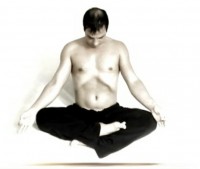Kapālabhāti Pranayama
Kapāla means skull Bhāti means light. This exercise gets its name because when practicing the mind fills with a bright light. This is due to the change in oxygen and energy levels received by the mind.
This is a vigorous breathing technique, stop before the muscles and lungs become fatigued. Always practice pranayama with care, watch the inner body like watching a young child, with careful attentive undisturbed focus.
The breathing in Kapalabhati is more rapid than in Bhastrika pranayama. This is because the breaths are more forceful during Bhastrika.

Stage 1 - Kapalabhati Pranayama
Find a comfortable seated position. Gently exhale all of the air from the lungs then inhale a little.
Exhale rapidly like a gentle sneeze making a sound with the mouth closed. Then inhale rapidly and begin to exhale and inhale in quick rhythm.
Use the diaphragm to create the force required for quick inhalation and exhalation.
Perform Ujjayi pranayama after 8 to 12 Kapalabhati inhalations and exhalations.
Gradually build up the number of Kapālabhāti breaths taken each time. Stop if the chest fatigues.
This breathing technique helps Ujjayi breathing because it opens the tiny air sacs in the lungs called alveoli. This is where the element of air is exchanged with the element of water. This makes inhalation (Pūraka) deeper and it helps in retaining the breath after inhalation (Antara Kumbhaka).

Stage 2 - Kapalabhati Pranayama
Inhale and exhale rapidly through both nostrils partially blocked. Control the air flow so that it enters evenly through the nostrils.
Perform 8 to 12 Kapalabhati inhalations and exhalations.
Practice a little Ujjayi pranayama after. Take at least 3 deep restorative breaths before beginning another Kapalabhati session.
Gradually build up the number of Kapālabhāti breaths taken.
Re-introduce the technique when the nerves and lungs feel restored after Ujjayi.
Optional: It is quite a common practice to hold (Antara Kumbhaka) after a number of Bhastrika or Kapalabhati breaths. This way the practitioner can measure their ability to hold the breath. This will increase dramatically after one session of breathing techniques.

Stage 3 - Kapalabhati Pranayama
Inhale and exhale rapidly through the right nostril with the left nostril fully blocked.
Breath in and out of the same nostril.
Switch after at least 5 breaths. So this time inhalations and exhalations are done through the left nostril.
Perhaps for some reason you want to start on the left nostril if this is the case reverse the order mentioned.
When the lungs fatigue begin to practice light Ujjayi breathing.
Optional: It is quite a common practice to hold (Antara Kumbhaka) after a number of Bhastrika or Kapalabhati breaths. This way the practitioner can measure their ability to hold the breath. This will increase dramatically after one session of breathing techniques.
Re-introduce the technique when the nerves and lungs feel restored.
This technique can be performed switching each time. It takes co-ordination and skill.

Stage 4 - Kapalabhati Pranayama
Inhale through the right nostril and exhale through the left.
Switch after at least 5 breaths.
When the lungs fatigue begin to practice light Ujjayi breathing.
Optional: It is quite a common practice to hold (Antara Kumbhaka) after a number of Bhastrika or Kapalabhati breaths. This way the practitioner can measure their ability to hold the breath. This will increase dramatically after one session of breathing techniques.
Re-introduce the technique when the nerves and lungs feel restored.
The nostrils can be switched each time which takes skill and co-ordination.

Stage 5 - Kapalabhati Pranayama
Inhale through both nostrils and exhale through the left then inhale through both nostrils and exhale through the right.
Switch the nostril that is exhaled through each time.
When the lungs fatigue begin to practice light Ujjayi breathing.
Optional: It is quite a common practice to hold (Antara Kumbhaka) after a number of Bhastrika or Kapalabhati breaths. This way the practitioner can measure their ability to hold the breath. This will increase dramatically after one session of breathing techniques.
Re-introduce the technique when the nerves and lungs feel restored.

Warning!
Vigorous breathing techniques that change the natural flow of breath significantly can be harmful. Do them with a caring reflection upon the inner bodies. Stop and enter a natural breathing pattern if the nervous system feels uneasy or fatigued. Practice this breathing technique for short periods of time and do passive breathing techniques after.



